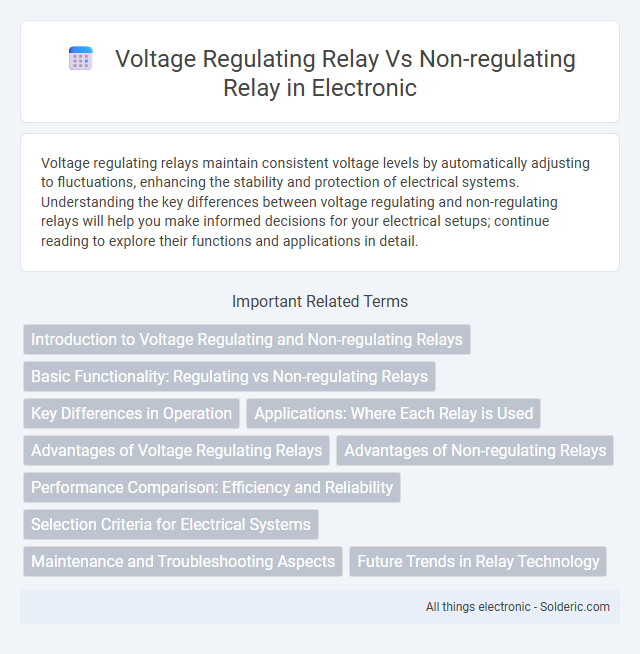Voltage regulating relays maintain consistent voltage levels by automatically adjusting to fluctuations, enhancing the stability and protection of electrical systems. Understanding the key differences between voltage regulating and non-regulating relays will help you make informed decisions for your electrical setups; continue reading to explore their functions and applications in detail.
Comparison Table
| Feature | Voltage Regulating Relay | Non-Regulating Relay |
|---|---|---|
| Function | Maintains constant voltage level by regulating input voltage | Detects voltage abnormalities without regulating voltage |
| Application | Voltage stabilization in power systems and equipment | Overvoltage or undervoltage protection in circuits |
| Operation | Adjusts voltage via feedback control | Trips circuit when voltage exceeds preset limits |
| Complexity | More complex, includes sensing and control mechanisms | Simpler, primarily sensing and switching |
| Cost | Higher due to added regulation features | Lower, basic protection relay |
| Example Usage | Voltage stabilizers, power quality improvement | Basic protection relays in distribution panels |
Introduction to Voltage Regulating and Non-regulating Relays
Voltage regulating relays are designed to maintain a constant voltage level by adjusting the excitation of a generator or transformer, ensuring stable power supply and protecting electrical equipment from voltage fluctuations. Non-regulating relays, in contrast, primarily serve protective functions such as overcurrent and fault detection without actively controlling voltage levels. The key difference lies in the voltage regulating relay's capability to dynamically manage voltage, whereas non-regulating relays focus on system protection and fault response.
Basic Functionality: Regulating vs Non-regulating Relays
Voltage regulating relays continuously monitor and adjust voltage levels to maintain a stable output within a predefined range, ensuring optimal performance and protection for electrical systems. Non-regulating relays operate on a fixed threshold, activating or deactivating the circuit only when the voltage crosses set limits, without intermediate adjustments. The primary difference lies in the regulating relay's ability to provide dynamic voltage control, whereas non-regulating relays respond solely to voltage deviations beyond fixed points.
Key Differences in Operation
Voltage regulating relays continuously monitor and adjust voltage levels to maintain a stable output within preset limits, ensuring optimal system performance and protection. Non-regulating relays act primarily as protective devices, triggering alarms or circuit breakers only when voltage deviates beyond fixed thresholds without actively controlling voltage fluctuations. The key operational difference lies in voltage regulating relays' dynamic feedback mechanism versus non-regulating relays' static threshold-based response.
Applications: Where Each Relay is Used
Voltage regulating relays are primarily used in power distribution systems to maintain a stable voltage output by automatically adjusting voltage levels, making them ideal for renewable energy sources, transformers, and industrial equipment requiring consistent voltage. Non-regulating relays are commonly found in simple switching operations, protection circuits, and control panels where voltage regulation is not critical, such as basic motor starters and lighting controls. Your choice between these relays depends on whether precise voltage control or simple switching functions are essential for your application.
Advantages of Voltage Regulating Relays
Voltage regulating relays maintain consistent voltage levels by automatically adjusting to fluctuations, enhancing the stability and protection of electrical systems compared to non-regulating relays. They reduce wear and tear on connected equipment by preventing overvoltage and undervoltage conditions, thereby extending the lifespan of electrical components. Voltage regulating relays also improve energy efficiency by minimizing power losses caused by voltage variations, leading to cost savings and improved system reliability.
Advantages of Non-regulating Relays
Non-regulating relays offer increased simplicity and reliability due to their straightforward design, reducing maintenance and operational errors. They provide stable voltage protection in systems where voltage regulation is constant or managed externally, ensuring consistent performance without complex adjustments. Your electrical setup benefits from cost-effective and durable solutions when using non-regulating relays in appropriate applications.
Performance Comparison: Efficiency and Reliability
Voltage regulating relays maintain stable voltage levels by continuously adjusting output, resulting in higher efficiency and improved system reliability compared to non-regulating relays, which lack this dynamic control and can cause voltage fluctuations. The precise voltage control of regulating relays reduces energy losses and equipment wear, enhancing overall performance and longevity. Your system benefits from fewer interruptions and maintenance needs with regulating relays, making them a superior choice for consistent voltage management.
Selection Criteria for Electrical Systems
Voltage regulating relays are essential for maintaining stable voltage levels and protecting electrical systems from fluctuations, making them ideal for applications requiring precise voltage control and system reliability. Non-regulating relays, while simpler and cost-effective, are typically selected for basic protection functions where voltage regulation is not critical. Your selection should consider factors such as system sensitivity, voltage stability requirements, load characteristics, and overall protection strategy to ensure optimal performance and equipment safety.
Maintenance and Troubleshooting Aspects
Voltage regulating relays require regular calibration and testing to ensure precise voltage control, involving specialized equipment and procedures specific to their control functions. Non-regulating relays generally demand less frequent maintenance, focusing on contact inspection and mechanical checks, simplifying troubleshooting efforts. Diagnosing faults in voltage regulating relays often involves analyzing voltage variations and relay response times, while non-regulating relays typically require straightforward continuity and operation tests.
Future Trends in Relay Technology
Future trends in relay technology emphasize the integration of voltage regulating relays with intelligent grid systems, enabling real-time monitoring and adaptive voltage control for enhanced stability in renewable energy applications. Non-regulating relays are gradually being supplemented by smart relays with advanced communication protocols, supporting predictive maintenance and reduced downtime. Advancements in materials and microelectronics continue to push relay capabilities towards higher efficiency, reliability, and miniaturization in power distribution networks.
Voltage Regulating Relay vs Non-regulating Relay Infographic

 solderic.com
solderic.com